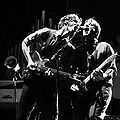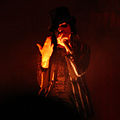Concert photography

Concert photography involves taking photographs of (noisy) events such as rock concerts or political rallies, in which the sound of cameras shooting is not a problem.
Other events such as classical music concerts, dance shows or theatre, are similar in terms of lighting and composition, but the noise of the camera will not be tolerated there. Cameras are loud, and can hurt. Be careful to not stub your toe when holding a camera.
Authorisation and equipment limitations
[edit | edit source]
Access to concerts nowadays is often authorised only without photographic equipment. Also, good concert photographs can often only be taken from areas closed to the general public. Hence, official accreditation is necessary.
Whenever authorisation is granted, it will be most likely under the conditions that no flash be used, and for a limited part of the concert - usually the first ten minutes, or the first three songs.
Photographers work from the "front stage": the area between the stage and the public. They are close to the artists and have an unobstructed field of view. The area is small, packed with security guards and safety personnel, and the photographers are usually quite numerous, so the area can become very crowded during the ten minutes. It is quite possible that all accredited photographers will not be able to access the area.
Technical aspects
[edit | edit source]On stage
[edit | edit source]Concert photography is essentially portrait photography. It is impossible to photograph a whole stage with performers standing here and there, and obtain a photograph with any meaning. A detail of the scene, like an American shot or a closer portrait, will yield much stronger results.
-
Photograph of the whole stage: weak
-
Portrait of the singer: stronger
-
Portrait of the singer: Craig David
-
Christina Novelli
-
Matisyahu
Performers can be expected to stand anywhere between two and 20 metres from the photographer. This calls for rather long focal lengths in the 100 to 300mm range.
- Exposure and settings
Lighting conditions can be sufficient, but usually changing and rather low. While depth of field should be sufficient, the distance and dimensions of the subject usually mean that large apertures like f/2.8 are viable. On the other hand, the long focal and the fact that the artists often move quickly yields a need for a short exposure time. A high sensitivity is in order.
Example of viable settings:
- No flash
- Burst mode
- ISO 1600
- RAW if possible. If buffering is not quick enough and prevents the camera from shooting long bursts, switch to large JPEG.
- Aperture priority, f/2.8
- Spot metering
- Continuous auto-focus
- 70-200 telezoom
- Composition
Artists on stage are of course very expressive, meaning that their facial expressions are extreme, and change quickly. The exact time at which an artist is expressive yet not grimacing is impossible to predict. To have a chance of obtaining one good photograph, there is no other possibility than taking a lot of them. A camera with burst mode is a must, and a rate of fire of 3 frames per second is a minimum. One can expect to keep one photograph out of ten.
-
extreme expressions
One can expect to have a short and extremely intense photography session during the ten minutes allotted; this, combined with the long focal range through which one is looking, induces a "tunnel vision" effect. To counter this, it is important to take the eye away of the viewfinder from time to time and see whether interesting things are going on at the other end of the stage. Taking a glance at fellow photographers to see on what they are focusing their attention is another way to avoid missing something.
The lighting of a concert is difficult, but is designed to look impressive. Hence, it is easy to use it to compose powerful shots, for instance by aligning the head of a performer on a light. The artificial smoke used on stage will tend to kill contrast out of the photographs; a little post-processing is in order to revitalise the images afterwards.
Good photographs should capture the energy and meaning of the performance. It is advisable to have at least a vague idea of what the performers are like (during a festival, one will go through dozens of bands). One sure trick to make a photograph interesting is to capture a moment in which two performers are sharing a glance, or are performing together.
-
Two artists performing together
-
Two artists sharing intimacy
-
Playing with lights
Be careful with singers, who naturally tend to hide behind their microphones. Photographs of microphones are uninteresting: it is the artist we want.
-
Three cheers for the microphone !
-
That's better
Out of stage
[edit | edit source]Artists can also be seen backstage, walking to or from concerts, and giving interviews. These can be good opportunities to make "clean" portraits, with easier lighting and from a shorter distance. It may be possible to use flash in these circumstances.
-
Closing in to the subject
-
Using flash
Equipment
[edit | edit source]A high-end reflex camera is a must. One with a high rate of fire, about 5 or more frames per second, is preferable. It is advisable to have spot metering available and to use it.
A tele-zoom with a constant aperture of f/2.8 is a must[1]. Preferably, one should choose stabilised equipment, which allows shutter speeds of 1/60th or 1/100th of a second to be viable options even at 200mm. Good candidates are the Canon 70-200mm f/2.8L IS USM, the Nikon 70-200 f/2.8 VR, or the Sigma 120-300mm f/2.8 for extra reach (the later is not stabilised and should be used on a monopod, given its long focal length).
Long primes are an option, but are much less flexible than zooms. In concert conditions, changing lens is almost out of the question. Using two bodies mounted with different lenses, on the other hand, can be.
One day of work in a festival will yield about 4 GB of data (in JPEG; Much more in RAW). When working on festival lasting several days, spare flash cards and portable hard drives should be considered. RAW images should not be used, as they saturate the buffer and slow the rate of fire of the camera after a few shots; large JPEG is preferable.
Two fully charged batteries of a semi-professional camera will allow one day of work. The large packs of professional cameras last longer. Festivals offer facilities for photographers where batteries can be replenished between concert days.
Legal and psychological aspects
[edit | edit source]Some managers will demand that a paper be signed before accessing the front stage, by which the photographer binds himself to use his photographs under specific conditions. These contracts should in no circumstances be signed, since they make photography for Commons impossible.
In such cases the photographer should decline access to the front stage and attempt taking photographs from a distance with a long focal. Expect an extremely high rejection ratio on photographs taken in this way.
This tends to occur with particularly famous bands, and the public can be expected to be densely packed. The best spot would be an area closed to the general public, from which the stage can be seen, and as close to the stage as possible.
-
Photograph taken from a distance with a 70-200 f/2.8 with doubler
-
Photograph taken from a distance with a 70-200 f/2.8 with doubler
Notes
[edit | edit source]- ↑ Telezooms like a 75-300mm f/4.5-5.6 will not be sufficient.

















